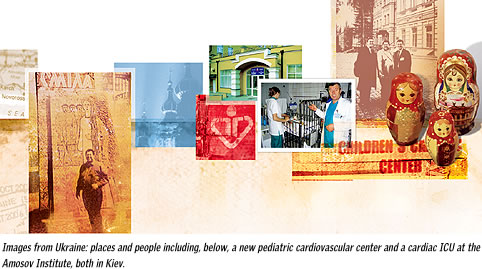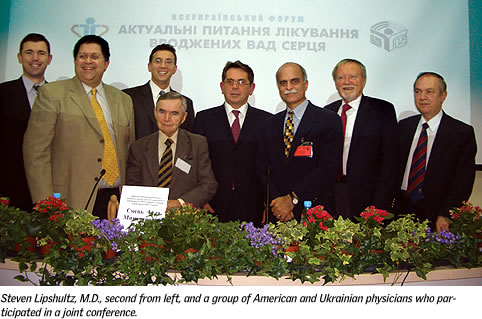
It turns out that you can go home again—even when you don’t
realize it’s home. That’s what Steven Lipshultz,
M.D., professor and chair of the Department of Pediatrics at
the University of Miami Miller School of Medicine, discovered
as he began a series of trips to Ukraine on a mission to improve
the health of the nation’s children.
Ukraine, the second largest country in Europe, has a population
of around 48 million. The country was declared an independent
economic state from Russia in 1991, but it was only after 2004’s “Orange
Revolution” that Ukraine moved toward democracy. Shortly
after the 2004 revolution, Lipshultz took his first trip to Ukraine
as part of a U.S. congressional and State Department delegation
examining children’s medical services and health. One area
of special concern was the availability and quality of care for
children born with heart diseases. “I was not able to find
consistent figures, but it appears that there are between 6,000
and 8,000 children who are born needing cardiovascular surgery
in Ukraine each year. However, not more than 1,500 of these children
actually receive cardiovascular surgery. That means there are
thousands of other children who need surgery, and most will die
or develop symptomatic irreversible heart disease without it,” Lipshultz
says. Touring the National Center for Pediatric
Cardiovascular Surgery in Kiev, Lipshultz observed many children
were hospitalized
due to symptoms related to heart disease that would have been
detected
and corrected early in life in the United States. Most were
suffering from the complications of not having been diagnosed
or treated
during that early critical therapeutic window. A very high
percentage of all children born with congenital heart disease
not compatible
with life—who do not have access to needed surgery—die
within the first year of life. And the rates of congenital
heart disease in Ukraine are among the highest in the world,
in part
due to birth defects related to the 1986 Chernobyl nuclear
disaster and other environmental teratogenic exposures.
“In the United States many of these infants and children would never need
surgery because specialists in pediatric interventional cardiology would be able
to balloon open sticky heart valves or close holes in the heart, among other
procedures, in the catheterization laboratory,” says Lipshultz. “Due
to limitations related to expenses, facilities, and training, interventional
pediatric cardiology has not been a realistic option for children throughout
Ukraine.”
Many of the children do not receive any
treatment at all, surgical or otherwise, and the fact that
they have heart disease
is never even discovered. “They
just die as babies,” explains Lipshultz. “Here, most children with
congenital heart disease receive treatment, grow up, and get on with their
lives. There, many of them are medically left alone and they die or suffer
many cardiac
disabilities.”
That was one of the harsh realities that
Lipshultz learned about Ukraine. Despite the sophistication
and grandeur of the
cities, Ukraine’s health care facilities
and systems are in many cases as meager as those in the poorest parts of the
world. A tour of the country’s “finest” pediatric cardiac critical
care unit showed that it had “ventilators that should have been retired
years ago,” says Lipshultz.
During that first visit to Ukraine, Lipshultz
discovered many things: hard-working, dedicated staff, deplorably
antiquated
facilities and equipment, inadequate training,
and something else—a deeper connection to Ukraine than he realized.
“Some of the officials said, ‘I know some people
who have your name—do
you have any relatives from here?’ And I said I had no idea where my
relatives were from; I just knew they were from Eastern Europe. My family never
spoke about
them because anybody who didn’t make it out was killed as a Jew living
in Eastern Europe,” Lipshultz says.
Lipshultz understood his parents’ silence—but
the questions of origin, of lost family members, of history,
persisted. For all he knew, family ties could
be a few miles away or around the corner in Kiev.
Upon his return to the States, Lipshultz
told his parents about the trip, then cautiously pressed
for more information.
His mother, who had become gravely ill,
simply didn’t recall much—except for Smila Soup. The borscht-like
soup, per tradition, was named for the cook’s village.
Lipshultz passed on the bit of information to his new Ukrainian
colleagues but was careful not to get excited about finding
kinship based on borscht. In the
meantime, he concentrated on strengthening the relationship between the medical
community in Ukraine and the Miller School.
As a result of that December 2005 visit,
a delegation of six Ukrainian pediatric specialists was sent
in January 2006
to attend the internationally renowned Masters
of Pediatrics educational program presented by the Miller School and to work
with UM’s Children’s Heart Center. Working closely with members of
the Children’s Heart Center team, including Steven E. Schultz, M.D.,
director of pediatric cardiac critical care medicine, and Eliot Rosenkranz,
M.D., chief
of pediatric cardiothoracic surgery, the Ukrainian delegation pledged to continue
to develop the relationship between the two groups to improve outcomes for
Ukrainian infants.
“We hardly manage to treat one-third of the children who need surgery,
so this
collaboration is very important,” says Igor Mokryk, M.D., a congenital
heart disease specialist.
Later that spring, the first lady of Ukraine
invited Lipshultz to address the Ukrainian leadership in
March and April 2006
to discuss the late health effects
in long-term survivors of radiation exposure during childhood at the government’s
humanitarian forum on the 20th anniversary of the Chernobyl disaster.
These trips culminated in the country’s first educational conference on
improving heart care outcomes in their new children’s heart surgical institute
in October 2006. The Ukraine minister of health declared the University’s
training program to be a national summit, which attracted hundreds of children’s
heart specialists from all parts of Ukraine.
On one of those trips, Lipshultz finally learned where his
family was from.
The mention of Smila Soup to his Ukrainian
friends led them to investigate this further on Lipshultz’s behalf—without his knowledge. The chief congenital
heart surgeon for Ukraine worked with the minister of health for Cherkasy Oblast,
the province where Smila is located. In April 2006 “they insisted that
I get in a car with one of the cardiac surgeons. I was initially not sure where
we were going but he drove me down to Smila, which is a city many hours outside
of Kiev in the central agricultural region of Ukraine,” Lipshultz says.
He arrived to a remarkable welcome.
“When we got there, I met with the mayor of the city, the assistant mayor
of the
city, and the physician who was in charge of all health care for the region,
and they brought me around to the neighborhood my family had lived in and other
memorable locations,” he says. He received the Medal of Smila, which
is adorned with symbols of courage, fortitude, and the victory of good over
evil.
After that heartwarming visit, Lipshultz
got back to medicine. “The head
doctor for the region took me to several of the hospitals—and for a city
with a population of 65,000 and for the surrounding region, I was told that there
was no service for any child with heart disease. For the entire province—this
is an area perhaps as large as Florida—there was not a single doctor who
specialized in the care of children with heart disease. They don’t have
ambulances or helicopters to easily transport the children to Kiev,” Lipshultz
says.

At the October conference, which coincided
with the opening of the first Ukraine National Children’s Heart Surgical Hospital, Lipshultz was joined by Schultz
and Rosenkranz as invited speakers, the only three non-Ukrainian faculty asked
to speak. The two UM physicians found their reception to be just as warm as Lipshultz’s
welcome had been.
“Our sponsors had to drag us out because their children’s heart specialists
just kept asking more and more questions and wanted more information,” Lipshultz
says. “The health care workers in Ukraine really want to learn, whether
they have the equipment—or will ever see the equipment or use the techniques
they were taught.
“That’s why we’re trying as hard as we can to help them in
any way, whether it be telemedicine, whether it be teleconferencing, whether
it’s
through having children’s heart specialists come to the University and
train, or having us help consult on how to build the best facilities and outfit
them. “There’s such an opportunity to make a difference. We’re
at the point
now where we can see a difference. I want to continue that momentum.” |